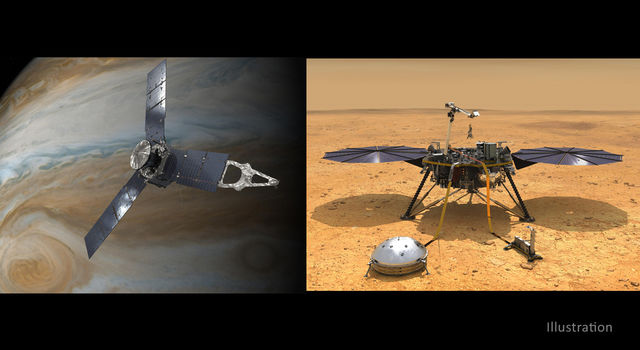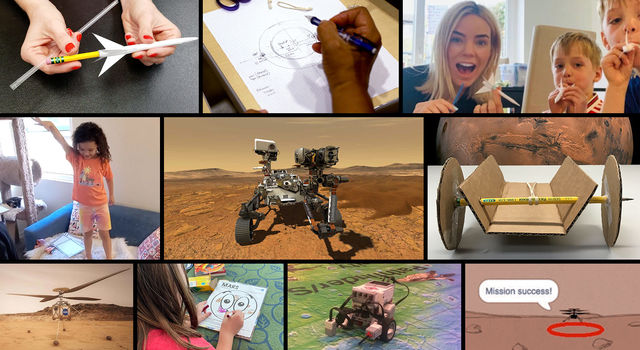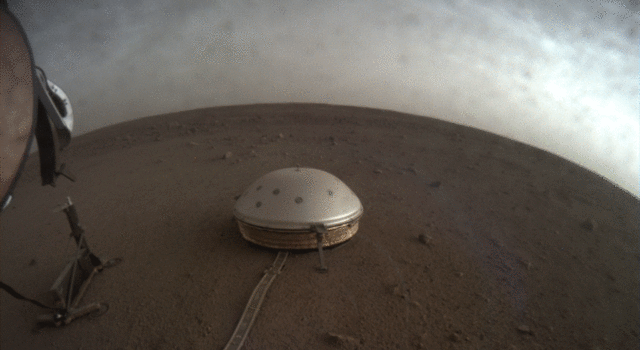Blogs | Dawn Journal | February 12, 2009
February 2009
Dear Charles Dawnwins,
Dawn continues to close in on Mars, ready for the gravitational slingshot that will help it on its expedition to the asteroid belt and its quest to gain insights into the evolution of the solar system. The ship remains on course, with the latest calculations of its trajectory being very close to those described in the last log. The spacecraft will streak about 549 kilometers (341 miles) above the planet at 4:28 p.m. PST on February 17.
While Dawn and Mars move in their separate orbits around the Sun, they are approaching each other at the stately pace of 2.56 kilometers/second (5720 miles/hour). Gradually, the gravitational pull of the planet will grow as the distance shrinks, and the spacecraft’s path will start to change, beginning the boost we seek. By about noon PST on February 14, the tug from Mars will have grown to be the same as the famously gentle thrust from Dawn’s ion propulsion system. When Dawn is closest to Mars, speeding past it at 5.31 kilometers/second (11,900 miles/hour), the red planet will be exerting 34,000 times greater force than the blue-green xenon beam generates.
Just as a swing speeds up as it approaches the bottom of its arc and slows down as it rises again, Dawn accelerates as it gains on the planet and decelerates as it climbs away. Unlike a swing, though (at least the kind your correspondent was allowed to play on as a youngster on Earth), Dawn will not retrace its path; it will not descend again after ascending from the vicinity of Mars. It is in its own orbit around the Sun and will move too swiftly by Mars for the planet to capture it into orbit.
To illustrate Dawn’s arc, let’s use the somewhat arbitrary speed of 4 kilometers/second (9000 miles/hour) as a reference. Over the coming days, Mars will attract Dawn, and the craft will have accelerated to that speed about 34 minutes before its closest point, still 5500 kilometers (3400 miles) away from the planet. After dipping still lower and falling still faster while it approaches Mars, the spacecraft will slow down as it departs. It will have decelerated to the same speed of 4 kilometers/second at 34 minutes after its closest encounter. Within a few days, the speed will have dropped to today’s value of 2.56 kilometers/second again. The arc of Dawn’s acceleration toward Mars matches the arc of its deceleration, displaying the same kind of symmetrical motion as a swing.
Where then is the effect of the gravity assist? Because Dawn is in orbit around the Sun, it is the distortion of that solar orbit caused by Mars that provides the advantage to the mission. In the previous log, we saw how the benefits of the gravitational interaction with Mars could be described as changes in the spacecraft speed. The 1.1 kilometers/second (2500 miles/hour) that represented the change in the shape of the orbit means that Dawn’s incoming speed and outgoing speed relative to the Sun are not the same, even though, as we saw above, they are the same relative to Mars. Before it reaches Mars, the probe will be traveling around the Sun at less than 25.5 kilometers/second (57,000 miles/hour). Thanks to the boost from Mars, the speed after the encounter will be more than 26.6 kilometers/second (59,500 miles/hour). The difference is precisely the effect described in the previous log.
The reshaping of Dawn’s orbit is different from the reorienting of the plane of the orbit, also explained in the previous log. The plane change from the gravity assist, of vital importance to the mission, does not manifest itself as a difference in the speed of the spacecraft around the Sun; it is a difference in the direction of motion. Nevertheless, the effect can be described as being equivalent to a change in speed (actually, in velocity), as it was in the last log. (For interested readers for whom these points are not already evident, please click here to go to the log that clarifies it. [Editor, I have not written such a log yet, although I will write an explanation in the future. In the meantime, please insert an acausal hyperlink for readers who do not want to wait.])
As Dawn plunges toward Mars, it will be coming in over the northern hemisphere, reaching above 60° latitude. As Mars bends the orbit, changing the direction the craft travels around the Sun, Dawn will depart over the southern hemisphere. Leaving the planet behind on its new path around the Sun, it will be above 60° south latitude.
The focus of the Dawn team’s work for the Mars encounter has been to achieve a trajectory that would deliver the probe to the target above Mars at the right time and traveling at the correct angle to accomplish the needed gravitational boost. As long as the spacecraft will be in the vicinity of such a familiar solar system site, albeit briefly, the team decided to take advantage of the occasion to calibrate the instruments that are designed to elucidate the nature of Vesta and Ceres. As mentioned at the end of the previous log, there is little Dawn can learn about Mars that is new. Indeed, it is flying higher and faster than spacecraft there right now. In addition, its instruments are intended for the initial examination of previously unexplored worlds, not the detailed investigation of a planet that already has been scrutinized by spacecraft for decades. That very scrutiny, however, means that there is a valuable database for use in comparing observations by Dawn’s instruments, helping to prepare them for their assigned tasks in the asteroid belt. Dawn’s observations at Mars, like the other, more distant measurements it has made of stars and planets since launch, help prepare for the real rewards of the mission. (To recapture the thrill of some of the previous in-flight observations, visit the logs of October 24, 2007, December 17, 2007, February 29 of any year, or April 22, 2008.)
Each instrument will acquire data to be used in comparisons with observations made by similar instruments on spacecraft dedicated to the study of Mars. Rather than using Dawn to learn about Mars, our focus is on using Mars to learn about the performance of our instruments. This will be helpful in doing science at Vesta and Ceres and in navigating there. As we will see in subsequent logs, the positions of Vesta and Ceres are not known accurately enough that Dawn could rendezvous with them using conventional radio navigation techniques alone. To improve the navigation, the craft will take images of the bodies as it is closing in on them, and analysis of those images by the Dawn navigation team will help pin down the location of the target. Tests at Mars will contribute to characterizing the camera not only for science, but for this separate function as well.
If Dawn’s encounter had represented a unique opportunity to conduct vital new science, the plans would have been different. As just one example, Dawn will not attempt to acquire the highest resolution visible images that it might be capable of achieving. Instead, by smearing the view of Mars across the camera’s line of sight, engineers will provide a relatively uniform illumination for the camera’s detectors, providing interesting engineering data that cannot be obtained when observing the pinpoint light of stars.
In preparation for the encounter, on January 20 controllers activated the gamma-ray and neutron detector (GRaND), which, despite its name, is a very modest (but wonderfully capable) member of the on-board instrumentation. The last time GRaND was operated was in April. It remains healthy and is continuing to work well, sensing the effects of cosmic radiation impinging on the spacecraft.
Dawn is approaching Mars from outside the planet’s orbit around the Sun. Therefore, from the spacecraft’s point of view, Mars and the Sun are close together, and Mars would appear to be a thin crescent. This geometry precludes directing its instruments toward the planet well before it arrives. Designed to operate in the more distant asteroid belt, the instruments would not be able to tolerate the heating from the Sun. Therefore, although GRaND is able to detect space radiation, there would be nothing for the other instruments to do while awaiting their calibrations at Mars.
These instruments will be activated on February 17 using instructions already stored onboard. Dawn will be pointing its main antenna to Earth, so the mission control team can observe telemetry, but there is no plan to send additional instructions then. The visible and infrared mapping spectrometer will be powered on at about 9:47 a.m. PST, and the primary science camera will be commanded on at about 1:21 p.m. PST. (The backup science camera has been used for other tests in flight, but it will not participate in the activities at Mars.) All the times presented here are as measured on the spacecraft. Mission controllers will have to wait more than 19 minutes, as radio signals traverse the great distance to Earth, to observe the associated telemetry. In essence, their entire view of events will be delayed by this “one-way light time.” (The Dawn project remains ready to advise the FCC on the use of such a system to provide a guaranteed delay in live broadcasting.)
At 1:57 p.m. PST, the spacecraft will begin turning to prepare for its calibration activities. The maneuver will move Earth out of the radio beam from the main antenna, so the spacecraft will switch to 1 of its 3 auxiliary antennas. Each of these antennas can emit a much broader beam, allowing communications over a wider range of orientations. The cost of spreading the signal over a much greater area is that when it is received at Earth, it is significantly weaker, so only a very limited amount of telemetry can be sent. For the subsequent day and a half, controllers will use this reduced flow of information to monitor Dawn’s work. Meanwhile, the instruments will attempt to record neutrons, gamma-rays, and ultraviolet, visible, and infrared light, all from Mars, all providing a bonus to the mission. (Dawn has previously conducted infrared observations of Mars. At that time the spacecraft was about 100,000 times farther from the planet than it will be when it swoops by next week.)
At 3:09 a.m. PST on February 19, Dawn will begin turning back to sight its main antenna on Earth once again. For more than a day, it will radio engineering data it stored during the time it could not transmit at high speed. At first, a Deep Space Network (DSN) antenna near Madrid, Spain, will receive the signals. As Earth rotates, the 34-meter (112-foot) dish will no longer be able to point to Dawn (as viewed from Madrid, Dawn will set in the west, just as the Sun, the moon, stars, and other celestial objects do), so a DSN antenna near Goldstone, California, will take over. After about 8 hours, the Goldstone facility will hand the responsibility over to a DSN antenna still farther west, near Canberra, Australia, which eventually will pass the baton once again to Madrid.
At 7:48 a.m. on February 20, the spacecraft will rotate again to bring its camera to bear on Mars. By then, the view of distant Mars will be similar to what the spacecraft will have as it navigates to Vesta, once again providing an opportunity to prepare for the visit to that mysterious world. At 11:28 a.m., it will turn away from Mars for the last time and resume transmitting data back to Earth 45 minutes later. The precious capabilities of the DSN are shared among all interplanetary spacecraft, so Dawn will return to more intermittent tracking on Friday. The return of data will be completed the following week.
All data that Dawn collects at Mars are considered a bonus of the mission. Indeed, when the mission was conceived, its launch was to be in 2006, and the mission to Vesta and Ceres then did not require the assistance of Mars. It was only in 2005, when the launch was rescheduled to 2007, that trajectory designers added Mars to the itinerary. The gravitational deflection is essential to the success of the mission, but the activities during the visit to Mars are secondary to the mission’s principal objectives.
Even before Dawn has paid a visit to Mars, engineers are already busy planning the details of the spacecraft’s next assignments. Following its brief divertissement at the planet, it will continue to coast in its orbit around the Sun until June. With Mars helping to reshape its orbit, there is no need for ion thrusting for a while. In the next few logs, we will follow along as Dawn engages in other work to be completed before the resumption of its most familiar function of reaching for the asteroid belt atop a blue-green pillar of xenon ions.
Dawn is 1.1 million kilometers (680 thousand miles) from Mars. It is 348 million kilometers (216 million miles) from Earth, or 910 times as far as the moon and 2.36 times as far as the Sun. Radio signals, traveling at the universal limit of the speed of light, take 39 minutes to make the round trip.
Dr. Marc D. Rayman
8:00 pm PST February 12, 2009
TAGS:DAWN, VESTA, CERES, DWARF PLANET, MISSION, SPACECRAFT







